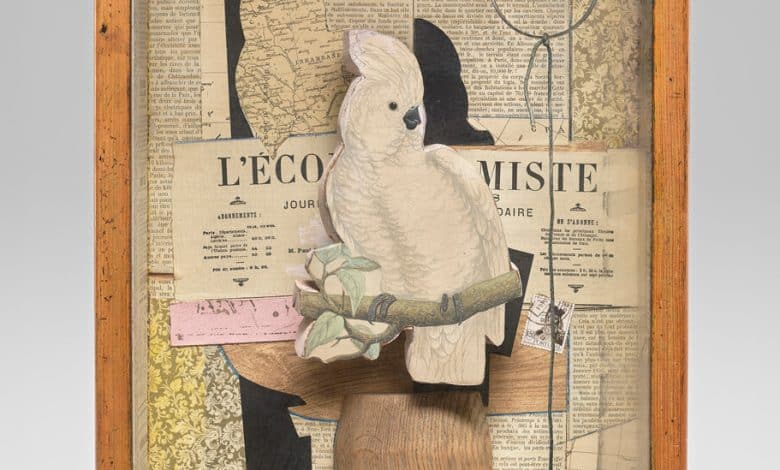National Gallery of Art Receives Major Gift of Joseph Cornell Boxes

Joseph Cornell, who died in 1972 at the age of 69, belongs to the tradition of the homebody-artist. A gray whisper of a man, he eschewed the excitements of travel in favor of a tea-filled life in his house on Utopia Parkway in Queens. His medium was the Box — that is, the Victorian-era shadow box, and he spent his days in his basement workshop, assembling cork balls, paper cutouts of birds and other dime-store material into improbably poetic arrangements that owed something to French Surrealism.
Among the cities he never visited was Washington, D.C. So one wonders what he would make of the news that the National Gallery of Art has just acquired a veritable truckload of his work — some 20 boxes and seven collages from throughout his career. The gift comes from Robert and Aimee Lehrman, Washington collectors.
Robert Lehrman,a trustee of the Hirshhorn Museum and a grandson of the co-founder of Giant Foods, a supermarket chain, has lectured extensively on Cornell and bought his first piece in the early 1980s. “It was a white dovecote box that had a childlike mystery about it,” he said. “I like that his work is both very simple and very complex.”
In some ways, it is hard to imagine Cornell’s intimate boxes nestled comfortably in the marble-clad halls of the National Gallery. The modest scale of his work, its whiff of the romantic past, puts it at odds with the epic proportions and air of officialdom of I.M. Pei’s East Wing, whose atrium alone is likely to boost a visitor’s daily step count.
On the other hand, Cornell seems perfect for the nation’s capital because his story is so archetypally American. He was obstinate, cranky and consumed with the beauty of common objects; he persisted with his art in the face of enormous loneliness. Living with his mother and his disabled brother, he found his inspiration in the work of other artists and dedicated his boxes to figures ranging from the composer Franz Schubert to the poet Emily Dickinson to the television actress Patty Duke.
The Lehrmans’ gift, comprising about half their Cornell holdings, “is major, major, major,” said Harry Cooper, the senior curator and head of modern and contemporary art at the National Gallery of Art. Although the museum has received far larger bequests, the gift, he said, is singular because it targets a single artist and presents his work in unusual depth.
“I would say that 20 Cornell boxes and seven collages puts us up there with the Art Institute as one of the two major collections of one of the great artists of the 20th century,” Cooper said. “That doesn’t happen every day.” The collection he mentioned at the Art Institute of Chicago consists of 37 works acquired in 1982, from the Chicago collectors Lindy and Edwin A. Bergman.
Taking its cue from the Bergman installation, the National Gallery will display its Cornells grouped together family style in a horizontal wall case in an upstairs gallery. It intends to keep several Cornells on view at all times; the first rotation opens on Thursday.
The works in the Lehrman gift range chronologically from 1939 to 1969. About half belong to Cornell’s lushly Surrealist style of the 1940s, featuring Medici princes and Romantic-era ballerinas. Others belong to the stripped-to the-bone style of the ’50s, especially the Aviary boxes, whose nearly empty, white-painted interiors can be seen as precursors of the geometric obsessions of the Minimalists of the ’60s.
The star of the collection is“A Parrot for Juan Gris” (1953-54), a quietly riveting object that features a paper cutout of a white cockatoo perched on a branch. An odd bird it is, dwelling in a dusty room that lacks a window or a view. The walls are lined with papery things — sheets of newspaper and fragments from a map.
In some ways, the bird may seem to anticipate a Washington type of person, someone ensconced in a newsy world, surrounded by headlines. But when you look closely, you see that the newspapers are in French and faded with age. The map is of Mozambique. As in every Cornell box, all paths lead away from the present and into the mists of the imagination.



